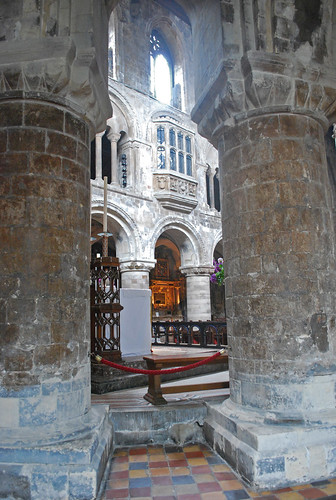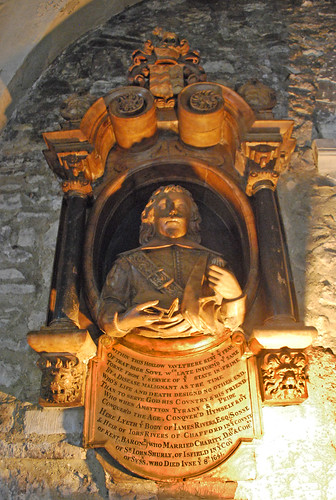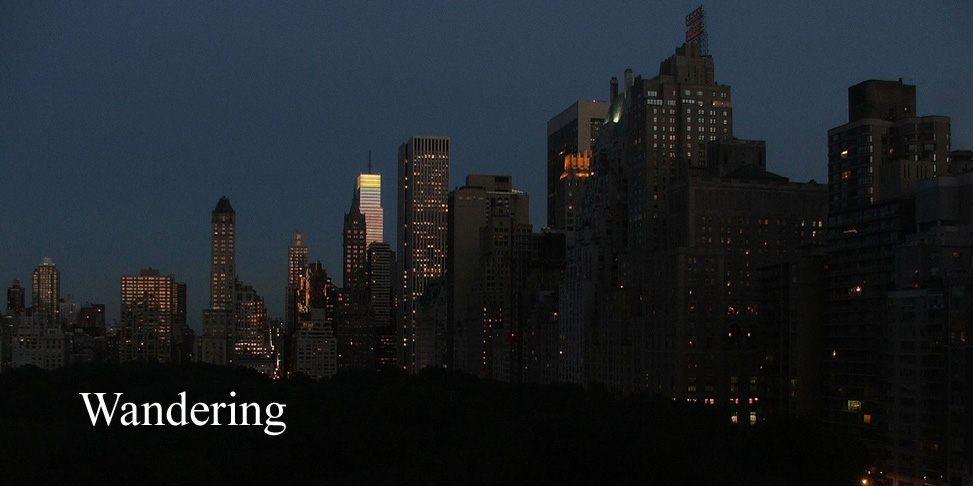
I visited the church or St Bartholomew the Great on bank holiday in May for no particular reason. The church has a long history going back to twelfth century. What remains is only part of the original structure. Large parts of the building were demolished on the dissolution of the monasteries in the sixteenth century and other parts were substantially altered and given over to secular use. The original Lady Chapel was bricked off, altered and became an ordinary house, before being further subdivided. Part of it became the printing works where Benjamin Franklin worked in 1725, and then a lace fringe factory. It was restored as a chapel in 1896.
The current state of the building recalls what could be its original appearance with thick Norman columns and walls of stone blocks.
I took some photographs of monuments on the walls there and gave them no further thought. The pictures were not particularly interesting images and I was about to discard them when I discovered British History Online, and excellent site containing digitised versions of historical documents, records and books including The records of St. Bartholomew's priory [and] St. Bartholomew the Great, West Smithfield: volume 2 Year (1921) by E.A Webb. This appears to be a very thorough review of historical records relating to the church; and it includes material about the monuments I photographed in May.
As far as I can tell from internet searching, none of the people for whom the memorials were erected was of any significance in history. We know of them by the pure chance that someone decided to erect a substantial memorial, and that the memorial has remained in a church whose fabric has been changed in the intervening years. Webb records that some of them have been moved from different locations in the church. I imagine there have been others lacking their decorative interest which have been removed and lost.
Monument to Percival and Agnes Smallpace

The Latin portion of the above inscription may be thus translated:
All welfare is vain.
Remember that death will not be long in coming and that the covenant of the grave hath been showed unto thee for the covenant of this world is 'He shall die the death'. All things come forth at their due season and pass away.
Judge none blessed before his death since it is in his sons that the man is known.
Percival Smalpace Esquire died the 2nd day of February A. D. 1558 in the reign of Queen Elizabeth. His body lies buried near this monument.
Agnes his wife and daughter of John Tebowld Esquire died the 3rd day of September A. D. 1588 in the reign of Elizabeth. Her body lies buried near this monument.
Their children Michael and Thomas are still living and in affectionate memory of their most excellent parents have erected this monument.
To the dying man all things become peaceful;
blessed are they who die in the Lord.
Posterity will award to each his due distinction. Be wise and adopt with reverence this precept: Thy life is of no account for thee, enrol thyself in the full service of the true God: proffer to Him prayers from thy heart, and express thy praise and thanksgiving. To this end was a man born. And, O! very far more steadfast is a faith which repentance renews. There are no parochial records of Percival Smalpace. From his will (fn. 8) we learn that he was one of the clerks of the Board of Green Cloth. The monument was restored by Mr. Gilbert J. Smallpiece in 1897.
The Board of Green Cloth, named for the covering of the board table, audited Royal accounts and made travel arrangements; athough its functions changed it continued until 2004.
Sir Robert Chamberlayne's Monument

In English: To Robert Chamberlayne, son of Robert by the institution of the pious happy and ever August James, of Great Britain France and Ireland, made a knight of the most noble order of the Bath; lord of the castle of Sherburn in the county of Oxford, descended by a long line of ancestors from the most ancient Earls of Tankerville in Normandy. Fit for any fortune, however great, born with an intellect and an equally great character, whilst cherishing these for himself and his own people, he also travelled many foreign countries, skilled in their habits and languages. Eventually he reverently approached the Holy Land and the Sepulchre of our Lord, and found also (alas) his own (sepulchre) of what kind or on what shore is unknown, dying in the year of the Virgin Birth 1615. A bachelor, far from his own people he perished by the inclemency of the weather or of man between (as far as can be guessed) Tripoli and Cyprus. A sorrowing friend, mindful of so sweet and old a companionship and unequal to support so great a grief and loss erected this (monument) (to a well deserving friend). He lived about 30 years.
He is covered by heaven though he has no tomb.
I wonder if he travelled for his own amusement; or whether he was a government agent of some kind; he was knighted by James I. And I don't know if pilgrimages to the Holy Land were common in the seventeenth century. I seems as if he went missing at sea between Tripoli and Cyprus; the "inclemency...of man" could refer to piracy which was common particularly off the African Coast. From 1609 to 1616, England lost 466 merchant ships to Barbary pirates.
And who was the sorrowing friend?
James Rivers

Within this hollow vault here rests the frame
Of that high soul wch. late inform'd the same
Torne from the service of the state in 's prime
By a disease malignant as the time
Who's life and death design'd no other end
Than to serve God his country and his friend;
Who when ambition rytanny and pride
Conquer'd the age, conquer'd himself and dy'd.
Here lyeth the Body of James Rivers Esq. (Sonne
and Heir of John Rivers of Chafford (fn. 59) in the County of Kent (Baront) who married Charity Dautr and Cohers of Sr. John Shurly, of Isfield in the Couy of Suss'x, Who died June the 8th 1641.
We learn from the parish registers that he was buried on the 9th June, the day after his death, 'out of the house of W. Freake Esq. the close side' from which, and from the fact that we find no other record of him in connexion with the parish, we assume that he was staying in the Close with a friend at the time and was not resident here. He probably died of the plague as did Sir George Hastings three weeks later. His great-grandfather, Sir John Rivers, Knight, of Chafford, was Lord Mayor of London in 1573. His father, Sir George Rivers, was made a Baronet in 1621 and was still living when his son died.
The monument was formerly on the south side of the quire on the spandrel over a circular pillar, from whence it was moved during the restoration of 1864 because it cut into the arch mouldings. It was at some period covered with black pitch, which was removed in the year 1912 when the inscription was re-written at the request and charge of a descendant, Mrs. Rivers-Moore.
At the moment, I have no idea why this and the next monument were, at some stage, covered in black pitch.
Edward Cooke, 1652.

A marble monument (covered with black pitch) in the south ambulatory on the west side of the entrance to the south chapel.
It can be seen that the black pitch has now been removed from this monument also.
Unsluce yor briny floods, what! can yee keepe
Yor eyes from teares and see the marble weepe,
Burst out for shame: or if yee find noe vent
For teares, yet stay, and see the stones relent.
The tablet is made of a stone which readily condenses the water from the air in damp weather; before the hot-water pipes were placed below drops would often be seen condensed upon it.
In English: Here lies interred all that is mortal of a truly reverend man, Edward Cooke, an exceedingly learned Philosopher as well as a very notable man of medicine, who, on the third of the ides (the 11th) of August A. D. 1652, and in the 39th year of his age, yielded perforce to nature in the sure hope of a resurrection.
Edward Cooke is described in the Parish Register in the record of his burial on the 14th of August 1652 as 'Doctor of Physick'. Otherwise his name does not occur in the parish records. His father, also Edward Cooke, occurs in the charter of the Society of Apothecaries, of which he was a Fellow in 1617.
Formerly this monument was on the opposite side of the south ambulatory, where it filled one of the stilted arches at the south-east corner of 'Purgatory'. The restoration of the apse necessitated its removal in 1864.
All of the italicised passages above come from 'Monuments, memorials and heraldry', The records of St. Bartholomew's priory [and] St. Bartholomew the Great, West Smithfield: volume 2 (1921), pp. 449-487.





No comments:
Post a Comment